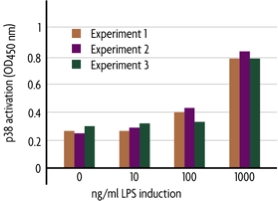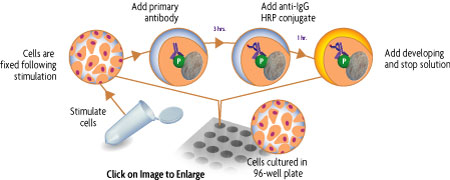THIS PRODUCT IS DISCONTINUED
Fast Activated Cell-based ELISA (FACE™) Kits provide a simple, sensitive method for detecting protein phosphorylation directly in the cell, without making extracts or performing electrophoresis and membrane blotting. These 96-well, high-throughput assays are available in both colorimetric and chemiluminescent formats for over 20 different targets (see list at right). For complete details, click the FACE™ Method tab below.
FACE p38 Kits provide 96 rxns each of 2 antibodies that enable you to monitor and compare the levels of both phosphorylated and total p38. The phospho-p38 antibody recognizes the p38 alpha, beta, gamma and delta isoforms only when phosphorylated at Thr180 and Tyr182. The total-p38 antibody recognizes p38 proteins regardless of their phosphorylation states. Click the p38 Info tab below for data and more information.
| Name | Format | Cat No. | 価格 (税抜) | |
|---|---|---|---|---|
| FACE™ p38 | 1 x 96 rxns | 48100 | Discontinued | |
| 5 x 96 rxns | 48600 | Discontinued | ||
| FACE™ p38 Chemi | 1 x 96 rxns | 48200 | Discontinued | |
| 5 x 96 rxns | 48700 | Discontinued | ||
| FACE™ p38 Manual |
| FACE™ Profile |
| Cell Biology Products Brochure |
| IsoCyte™ Application Note – Phospho-Protein Detection |
| MSDS: Sodium Azide |
| MSDS: Sulphuric Acid |
| MSDS: Thimersol |

Figure 1: Colorimetric measurement of phosphorylated p38.
Macrophage 4/4 cells were cultured in 96-well plates. Cells were induced with the indicated amount of lipopolysaccharide (LPS) for 20 minutes. Phosphorylation of p38 was assayed in triplicate using the FACE p38 Kit. Cell numbers in each well were normalized using Crystal Violet.
Antibody Specificities
The phospho-p38 antibody is specific for phosphorylated p38 and was raised against a peptide phosphorylated on residues that correspond to the sequence surrounding Thr180 and Tyr182 of human p38. It recognizes p38 alpha, beta, gamma and delta isoforms. The total-p38 antibody recognizes p38 MAPK regardless of its phosphorylation state.
p38 MAPK Overview
p38 MAP kinase is a member of the Mitogen Activated Protein Kinase (MAPK) family of proteins. It was first identified in a screen for drugs inhibiting tumor necrosis factor-mediated inflammatory responses. p38 MAPK is activated in response to a variety of stimuli including growth hormones, ligands for G-protein coupled receptors, inflammatory cytokines and stresses such as osmotic shock and heat shock. Because of its critical role in inflammation regulation and stress response, p38 MAPK is of great interest in both basic and therapeutic research, making high-throughput study methods in demand.
FACE™ の使用法
96ウェルプレートで細胞を培養し, 目的の経路を誘導する刺激を与えます。刺激を与えた後, 細胞を固定することでリン酸化を含むタンパク質修飾が保持されます。ブロッキング反応の後, それぞれのウェルに目的タンパク質に特異的な一次抗体, 続いてHRP標識二次抗体を加えます。その後, 発色試薬を加えることにより, 比色定量または化学発光による定量を簡便に行うことができます (図1)。また, キット付属のCrystal Violetを用いて細胞数を補正することができます。それぞれのFACE Kitには目的タンパク質全体とリン酸化型を認識する一次抗体が含まれます。これにより, 細胞数と細胞中の目的タンパク質の総量に対してのリン酸化型タンパク質量を解析することができます。FACEはリン酸化型タンパク質を解析することのできるキットで, 定量的かつ再現性のある結果が得られます。
図1: FACE の操作法
Contents & Storage
Two (or ten) 96-well plates for culturing cells, 96 (or 5 x 96) rxns each of two primary antibodies (1 phospho-specific, 1 specific for native protein), HRP-conjugated secondary antibody, Quenching Solution, 1X Antibody Blocking Buffer, 1X Antibody Dilution Buffer, 10X PBS, 10% Triton X-100, 1% SDS Solution, Developing and Stop Solutions, and Crystal Violet Cell Quantification Solution. Storage conditions vary from room temperature to -20°C, see manual for details. All reagents are guaranteed stable for 6 months when stored properly.


